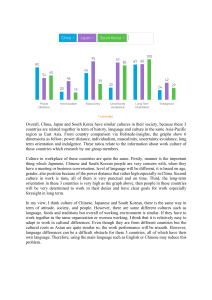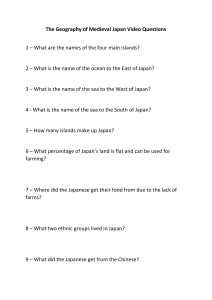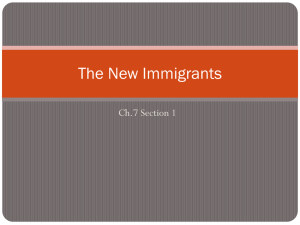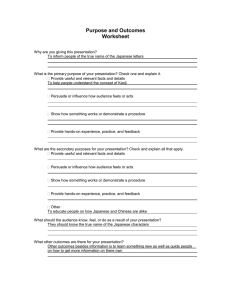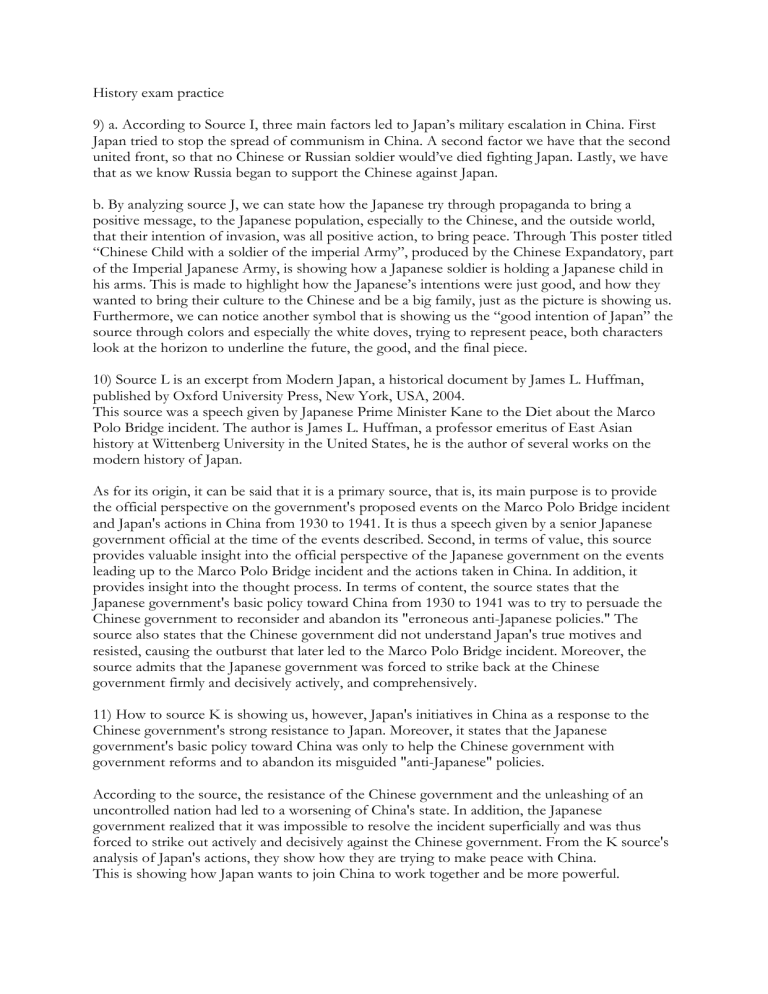
History exam practice 9) a. According to Source I, three main factors led to Japan’s military escalation in China. First Japan tried to stop the spread of communism in China. A second factor we have that the second united front, so that no Chinese or Russian soldier would’ve died fighting Japan. Lastly, we have that as we know Russia began to support the Chinese against Japan. b. By analyzing source J, we can state how the Japanese try through propaganda to bring a positive message, to the Japanese population, especially to the Chinese, and the outside world, that their intention of invasion, was all positive action, to bring peace. Through This poster titled “Chinese Child with a soldier of the imperial Army”, produced by the Chinese Expandatory, part of the Imperial Japanese Army, is showing how a Japanese soldier is holding a Japanese child in his arms. This is made to highlight how the Japanese’s intentions were just good, and how they wanted to bring their culture to the Chinese and be a big family, just as the picture is showing us. Furthermore, we can notice another symbol that is showing us the “good intention of Japan” the source through colors and especially the white doves, trying to represent peace, both characters look at the horizon to underline the future, the good, and the final piece. 10) Source L is an excerpt from Modern Japan, a historical document by James L. Huffman, published by Oxford University Press, New York, USA, 2004. This source was a speech given by Japanese Prime Minister Kane to the Diet about the Marco Polo Bridge incident. The author is James L. Huffman, a professor emeritus of East Asian history at Wittenberg University in the United States, he is the author of several works on the modern history of Japan. As for its origin, it can be said that it is a primary source, that is, its main purpose is to provide the official perspective on the government's proposed events on the Marco Polo Bridge incident and Japan's actions in China from 1930 to 1941. It is thus a speech given by a senior Japanese government official at the time of the events described. Second, in terms of value, this source provides valuable insight into the official perspective of the Japanese government on the events leading up to the Marco Polo Bridge incident and the actions taken in China. In addition, it provides insight into the thought process. In terms of content, the source states that the Japanese government's basic policy toward China from 1930 to 1941 was to try to persuade the Chinese government to reconsider and abandon its "erroneous anti-Japanese policies." The source also states that the Chinese government did not understand Japan's true motives and resisted, causing the outburst that later led to the Marco Polo Bridge incident. Moreover, the source admits that the Japanese government was forced to strike back at the Chinese government firmly and decisively actively, and comprehensively. 11) How to source K is showing us, however, Japan's initiatives in China as a response to the Chinese government's strong resistance to Japan. Moreover, it states that the Japanese government's basic policy toward China was only to help the Chinese government with government reforms and to abandon its misguided "anti-Japanese" policies. According to the source, the resistance of the Chinese government and the unleashing of an uncontrolled nation had led to a worsening of China's state. In addition, the Japanese government realized that it was impossible to resolve the incident superficially and was thus forced to strike out actively and decisively against the Chinese government. From the K source's analysis of Japan's actions, they show how they are trying to make peace with China. This is showing how Japan wants to join China to work together and be more powerful. 12) Source 1, by George E. Taylor, states that Japan's China policy was focused on intimidating Chinese farmers to control them and provide a social basis for Japanese rule. The source also is saying, that to prevent the peasants from supporting the Chinese guerrillas, the Japanese took severe retaliatory measures and treated the peasants very harshly. Source 2, by James L. Huffman, describes Japan's China policy as an attempt to negotiate with the Chinese government and get them to drop their anti-Japanese policies. The Chinese government did not understand Japan's real motives and instead resisted, leading to the outbreak of the Marco Polo Bridge incident. Therefore Japanese government was forced to take comprehensive and decisive action against the Chinese government. The Russian tactic worked, the sources said, and therefore Japanese responded with a full-scale invasion of China. The source also states that the Japanese feared the spread of communism in China and were determined to stop it with their usual escalated military solutions. Generally speaking, Japan’s China policy and China's policy from 1931 to 1941 are multifaceted. Using a combination of coercion and negotiation, their purpose was to control and stabilize China, fearing the spread of communism in China, and hoping to persuade the Chinese government to adopt a pro-Japanese policy. However, these policies have led to serious human rights violations and war crimes and ultimately failed to achieve their goals. In reality, Japan was seeking to expand its territory and resources. Japanese military leaders had gained power in the government, and conquering China had become their main goal. In addition, Japan wanted to gain a dominant position in East Asia to control the economy, society, and government, including all raw materials. Sources say that Japanese policy in China was carried out through a series of measures of military force. The Japanese military played a key role in these policies and was responsible for many of the aggressions committed against the Chinese people. In conclusion, all Japanese policies toward China from 1931 to 1941 were strongly influenced by their imperialistic ambitions, and a strong desire to establish a zone of power in East Asia and total control in China. This was then carried out with a combination of military force, and much pressure. Ultimately, these policies failed to achieve their goals and fostered Japan's defeat in World War II.
